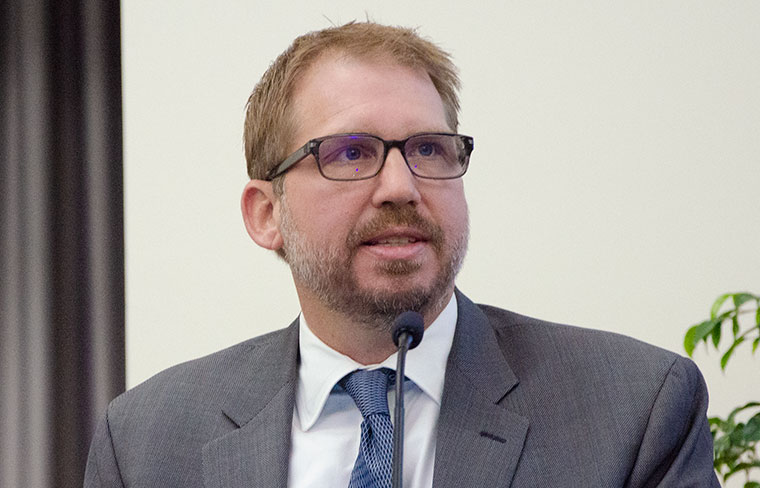
An SSAT joint symposium with the International Society of Digestive Surgery (ISDS) at DDW® on Tuesday, May 21, featured a series of presentations covering the latest evidence-based updates on paraesophageal, inguinal, ventral and parastomal hernia repairs.
Garth R. Jacobsen, MD, FACS, of the University of California, San Diego, opened the symposium with a discussion of inguinal hernia repair, including indications for conservative management, the utilization of mesh and current surgical guidelines.
“The inguinal hernia remains one of the most investigated disease processes, and while the literature is vast, it can be a bit confusing,” Dr. Jacobsen said. “Continuing efforts at meta-analysis of the data is helpful, and newly updated guidelines are even more so.”
Regarding conservative management, he said that minimally symptomatic hernias can be watched, but noted that most minimally symptomatic hernias will eventually become symptomatic.
Looking at the use of mesh, Dr. Jacobsen said that recent literature continues to suggest that mesh reduces the likelihood of recurrence.
“Compared to non-mesh repairs, patients are more likely to have seromas and less likely to have postoperative urinary retention and injury to nerves or blood vessels,” he said. “Additionally, studies have shown that mesh repairs are quicker with shorter hospital stays and sooner return to work.”
Finally, looking at surgical options, Dr. Jacobsen said that robotic technology is on the rise and will need further investigation, as the data is sparse but promising.

Ezra Teitelbaum, MD, of the Northwestern University Feinberg School of Medicine, Chicago, IL, followed with an update on treating patients with paraesophageal hernia.
“Laparoscopic paraesophageal hernia repair is indicated in patients with symptoms and many asymptomatic patients may also benefit,” Dr. Teitelbaum said. “A thorough preoperative workup is required and includes an EGD to evaluate the lumen, an esophagram or CT to define the anatomy, and manometry in order to rule out primary esophageal motility disorder, plan for complete versus partial fundoplication and to determine baseline in case of post-operative dysphagia.
Intraoperatively, he said the key principles to adhere to include achieving adequate intra-abdominal esophageal length, noting that Collis gastroplasty should be performed if necessary.
“Do not use permanent mesh. Absorbable mesh may reduce short-term recurrences, but we’ve seen no level 1 evidence of long-term benefit,” Dr. Teitelbaum said. “If there is undue tension on hiatal closure, use a diaphragm-relaxing incision. New onset of symptoms postoperatively should be thoroughly evaluated.”

Eric M. Pauli, MD, FACS, FASGE, of Penn State Hershey Medical Center, discussed the management of open surgical repair of ventral hernia, including new evidence on the effects of smoking on surgical morbidity, considerations regarding patients taking immunosuppressive agents and the use of mesh in contaminated cases.
“It turns out that smoking and immunosuppression may not affect wound events as much as we have feared,” Dr. Pauli said. “Many surgeons do not offer open ventral hernia repair or perform component separation in the setting of actively smoking patients, but it now seems that active smoking results in clinically insignificant differences in wound complications after open ventral hernia repair.”
Immunosuppression, he said, is associated with increased rates of surgical site occurrence (SSO), but not with surgical site infection (SSI) or procedural interventions for SSO.
“Regarding the use of mesh, the rapid integration of macroporous monofilament mesh in the sublay space may favor its use in clean contaminated and contaminated cases,” Dr. Pauli said.

Arielle J. Perez, MD, MPH, MS, of the University of North Carolina at Chapel Hill, concluded the symposium with a discussion on parastomal hernia repair.
“Approximately 100,000 new colostomies and ileostomies are created every year,” she said. “And the incidence of parastomal herniation ranges from 28% for end ileostomy and up to 48% for end colostomy. Recurrence rates of parastomal hernias after repair ranges from 50-76% after primary repair and from 24-86% after relocation.”
Prevention, she said, is key and multiple means of prevention have been discussed in the literature to prevent parastomal hernia formation.
“Location of the stoma at a lateral pararectus versus a transrectus location has been also suggested to reduce the risk of parastomal hernia,” Dr. Perez said. “Proponents of the first technique argue that the integrity of the rectus muscle and sheaths is preserved with minimization of the anterior abdominal wall disruptions and a consequent reduction of the risk of hernias at a lateral position of the stoma.”



